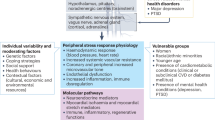Abstract
Increasing evidence suggests that psychological risk variables (e.g., anxiety sensitivity) may act as premorbid risk factors for the development of physical illness and psychopathology such as clinical anxiety and cardiovascular disease. The principal aim of the present study was to prospectively evaluate the degree to which these factors affected mental and physical health-related impairment and disability. A large nonclinical sample of young adults (N = 1296) was prospectively followed during a highly stressful period of time (i.e., military basic training). Consistent with expectation, each of the hypothesized risk factors contributed to the prediction of at least one index of impairment (e.g., visits to health clinic) after controlling for demographic factors, fitness, and history of psychiatric treatment. Moreover, gender interacted with risk factors in predicting outcomes suggesting that females with high anxiety sensitivity, relative to males with high anxiety sensitivity, are particularly prone to develop impairment during stress.
Similar content being viewed by others
REFERENCES
Schmidt NB, Lerew D, Trakowski JJ. Body vigilance in panic disorder: Evaluating attention to bodily perturbations. J Consult Clin Psychol 1997; 65: 214–220.
Taylor S, Koch WJ, McNally RJ. How does anxiety sensitivity vary across the anxiety disorders? J Anx Disord 1992; 6; 249–259.
Telch MJ, Lucas JA, Schmidt NB, Hanna HH, Jaimez TL, Lucas R. Group cognitive-behavioral treatment of panic disorder. Behav Res Ther 1993; 31: 279–287.
Schmidt NB, Trakowski JH, Staab JP. Extinction of panicogenic effects of a 35% CO2 challenge in patients with panic disorder. J Abnorm Psychol 1997; 106: 630–638.
Donnell CD, McNally RJ. Anxiety sensitivity and panic attacks in a nonclinical population. Behav Res Ther 1990; 28: 83–85.
Harrington PH, Schmidt NB, Telch MJ. Prospective evaluation of panic potentiation following 35% CO2 challenge in a nonclinical sample. Am J Psychiat 1996; 153: 823–825.
Schmidt NB, Telch MJ. The role of safety information and fear of bodily sensations in moderating responses to a hyperventilation challenge. Behav Ther 1994; 25: 197–208.
Rapee RM, Medoro L. Fear of physical sensations and trait anxiety as mediators of the response to hyperventilation in nonclinical subjects. J Abnorm Psychol 1994; 103: 693–699.
Telch MJ, Silverman A, Schmidt NB. The relationship between anxiety sensitivity and perceived control in a caffeine challenge. J Anx Disord 1996; 10: 21–35.
Schmidt NB, Lerew DR, Jackson RJ. The role of anxiety sensitivity in the pathogenesis of panic: Prospective evaluation of spontaneous panic attacks during acute stress. J Abnorm Psychol 1997; 106: 355–364.
Reiss S, McNally RJ. The expectancy model of fear. In Reiss, S Bootzin, RR, eds. Theoretical issues in behavior therapy. New York: Academic Press, 1985, pp. 107–121.
Taylor S. Anxiety sensitivity: Theory, research, and treatment of the fear of anxiety. Hillsdale, NJ: Erlbaum, in press.
Pennebaker JW. The psychology of physical symptoms. New York: Springer-Verlag, 1982.
Ehlers A, Breuer P. Increased cardiac awareness in panic disorder. J Abnorm Psychol 1992; 101: 371–382.
McLeod DR, Hoehn-Saric R. Perception of physiological changes in normal and pathological anxiety. In: Hoehn-Saric R, McLeod DR eds. Biology of anxiety disorders. Washington, DC: American Psychiatric Press, 1993, pp. 223–243.
Beunderman R, van Dis H, Duyvis D. Eine Vergleichsstudie somatischer und psychologischer Symptome bei Patienten mit nicht kardial bedingtem Brustchmerz und solchen mit Myokardinfarkt. In: Nutzinger DO, Pfersmann D, Welan T, Zapotoczky HG, eds. Herzphobie, Stuttgart: Enke, 1987, pp. 56–65.
Weissman MM. Panic disorder: Impact on quality of life. J Clin Psychiat 1991; 52: 6–8.
Schmidt NB, Cook J. Pain and discomfort intolerance in patients with panic disorder, manuscript under review.
Asmundson GJG. Anxiety sensitivity and chronic pain: Empirical findings, clinical implications, and future directions. In: Taylor S. ed. Anxiety sensitivity: Theory, research, and treatment of the fear of anxiety. Hillsdale, NJ: Erlbaum, in press.
Lerew D, Koselka M, Schmidt NB. Prospective Evaluation of Gender Differences in the Development of Psychopathology and Physical Health Disability During Basic Training. Poster presented at the American Psychological Association, August 1997.
Peterson RA, Reiss S. Test Manual for the Anxiety Sensitivity Index. Orland Park, Illinois: International Diagnostic Systems, 1987.
Telch MJ, Shermis MD, Lucas JA. Anxiety sensitivity: Unitary personality trait or domain-specific appraisals? J Anx Disord 1989; 3: 25–32.
Maller RG, Reiss S. Anxiety sensitivity in 1984 and panic attacks in 1987. J Anx Disord 1992; 6: 241–247.
McNally RJ. Panic disorder: A critical analysis. New York: Guilford Press, 1994.
Beck AT, Epstein N, Brown G, Steer RA. An inventory for measuring clinical anxiety: Psychometric properties. J Consult Clin Psychol 1988; 56: 893–897.
Borden JW, Peterson DR, Jackson EA. The Beck Anxiety Inventory in nonclinical samples: Initial psychometric properties. J Psychopathol Behav Assess 1991; 13: 345–356.
Beck AT, Steer RA, Garbin MG. Psychometric properties of the Beck Depressions Inventory: Twenty-five years of evaluation. Clin Psychol Rev 1988; 8: 77–100.
Knapik JJ, Jones BH, Reynolds KL, Staab JS. Validity of self-assessed physical fitness. Am J Prev Med 1992; 8: 367–372.
Schmidt NB, Koselka M. Gender Differences in Patients with Panic Disorder: Evaluating Cognitive Mediation of Phobic Avoidance. Cog Ther Res, in press
Stewart SH, Taylor S, Baker JM. Gender differences in dimensions of anxiety sensitivity. J Anx Disord 1997; 11: 179–200.
Author information
Authors and Affiliations
Rights and permissions
About this article
Cite this article
Schmidt, N.B., Lerew, D.R. Prospective Evaluation of Psychological Risk Factors as Predictors of Functional Impairment During Acute Stress. J Occup Rehabil 8, 199–212 (1998). https://doi.org/10.1023/A:1021378523582
Issue Date:
DOI: https://doi.org/10.1023/A:1021378523582




